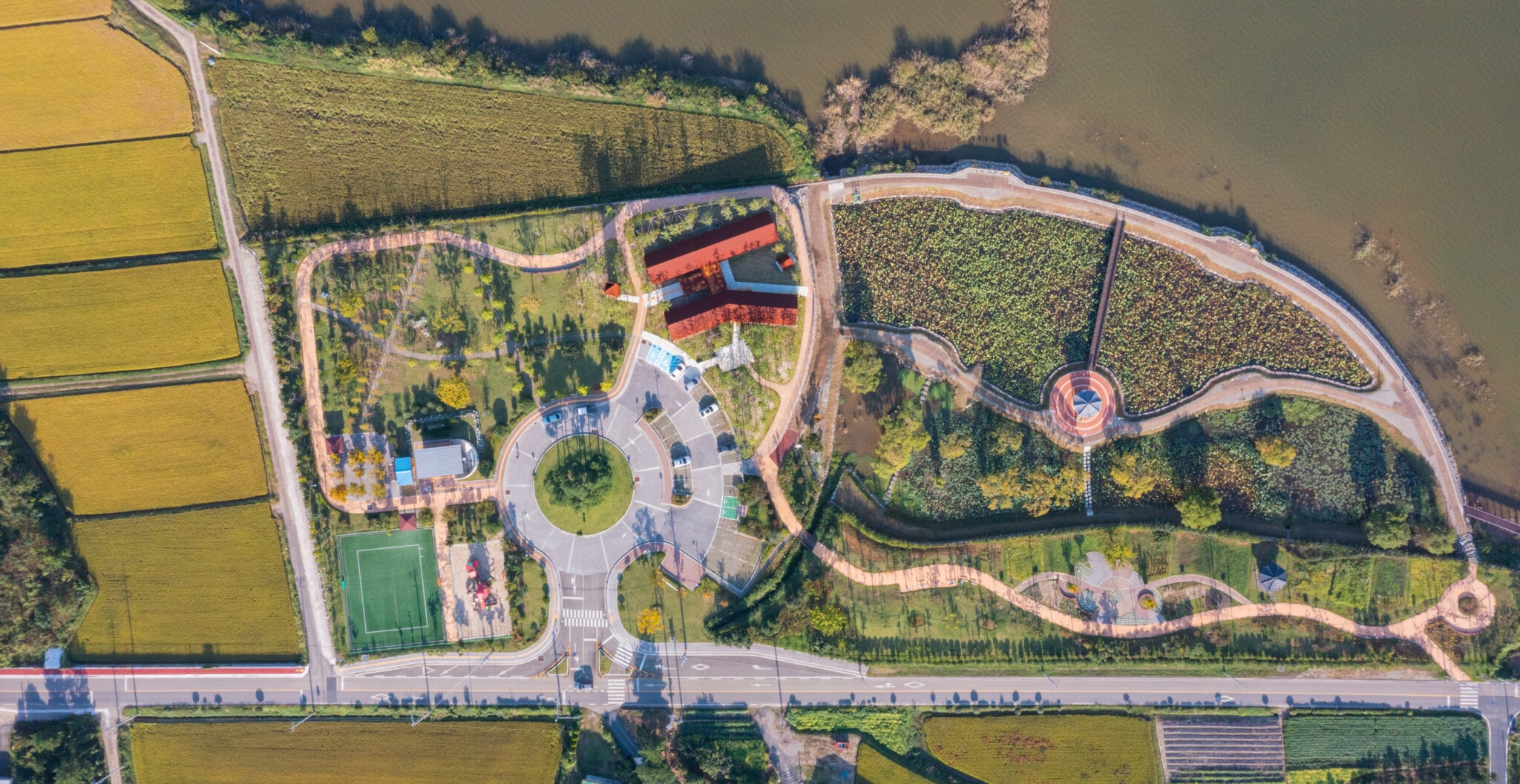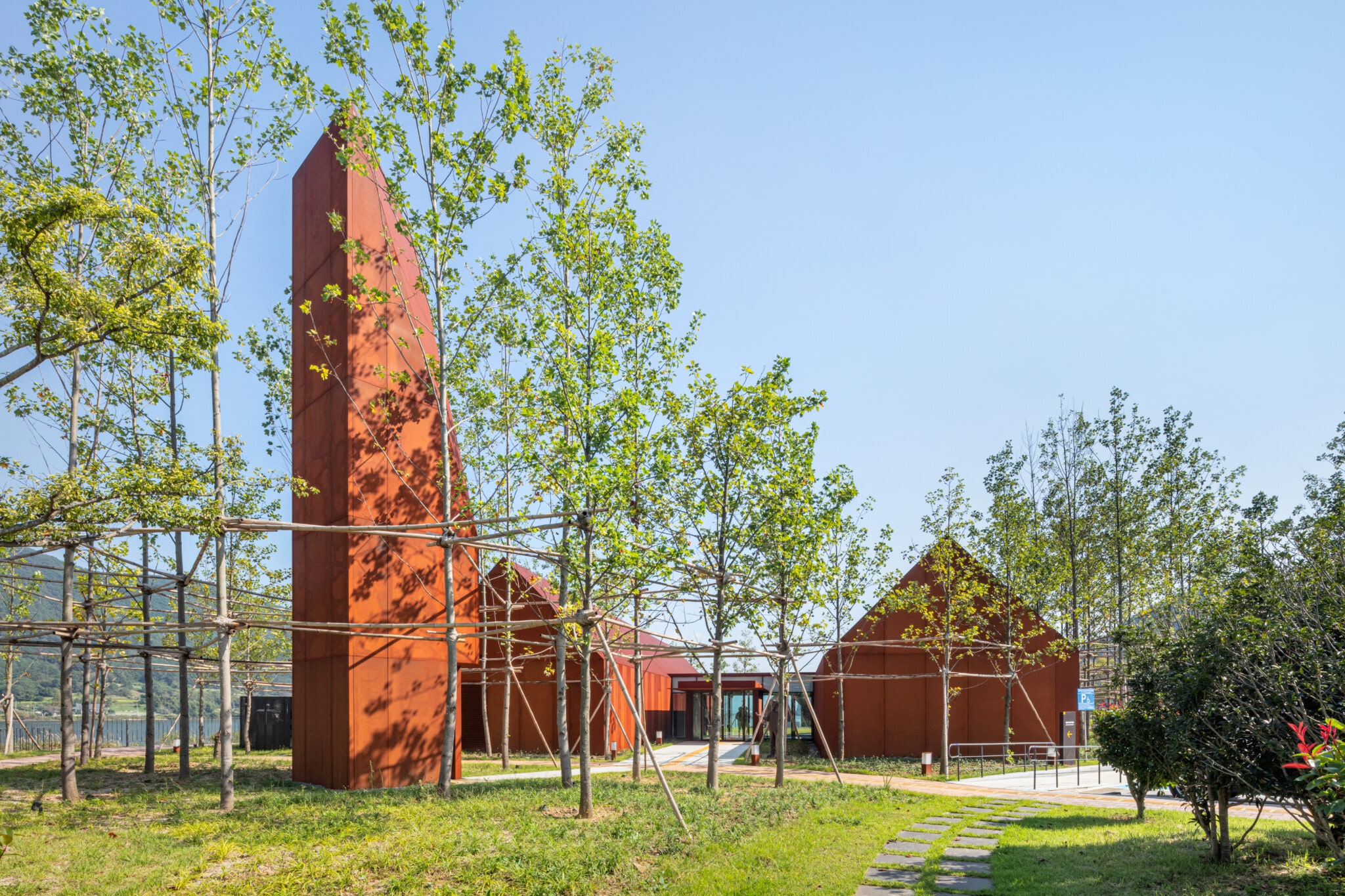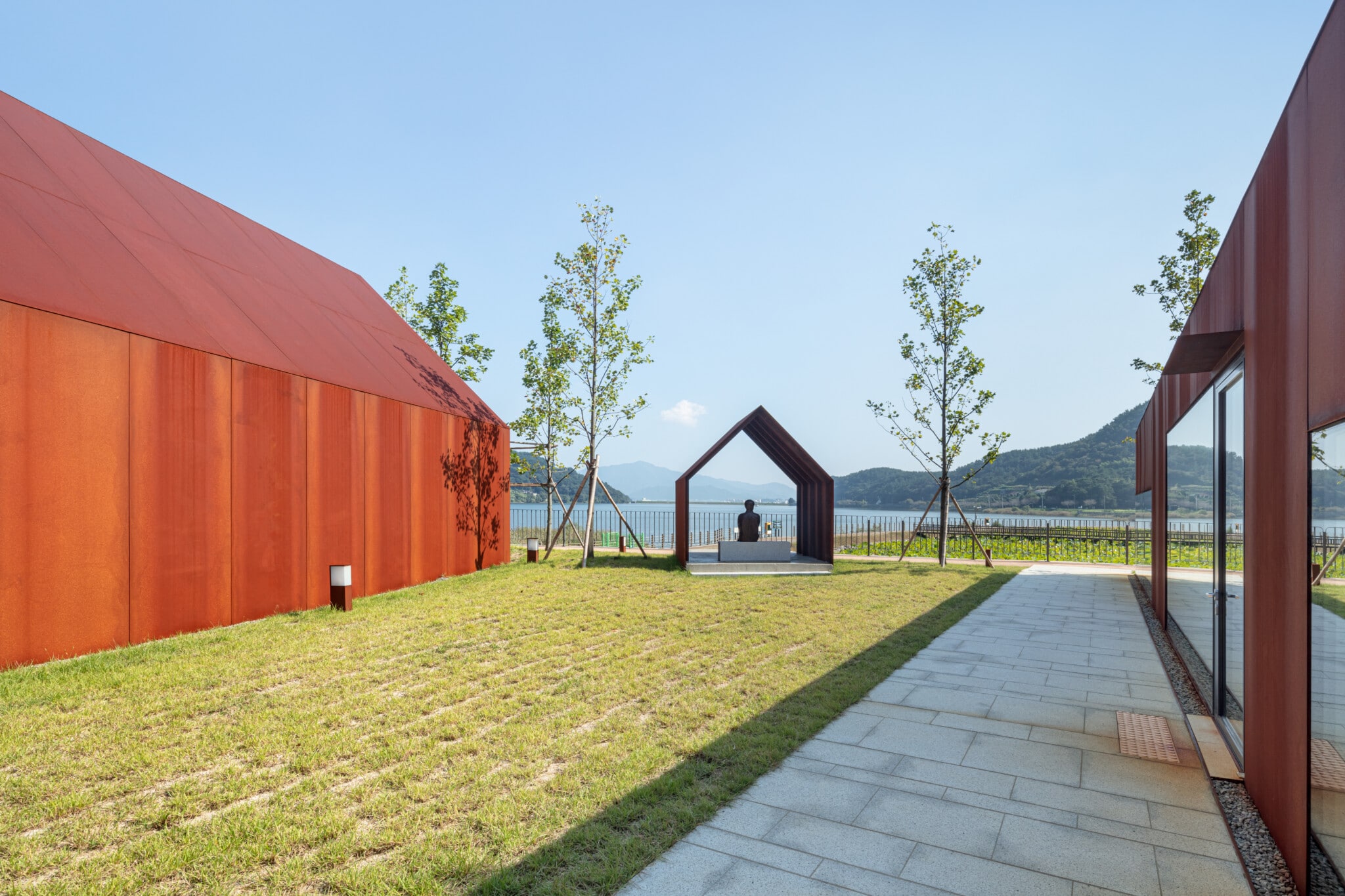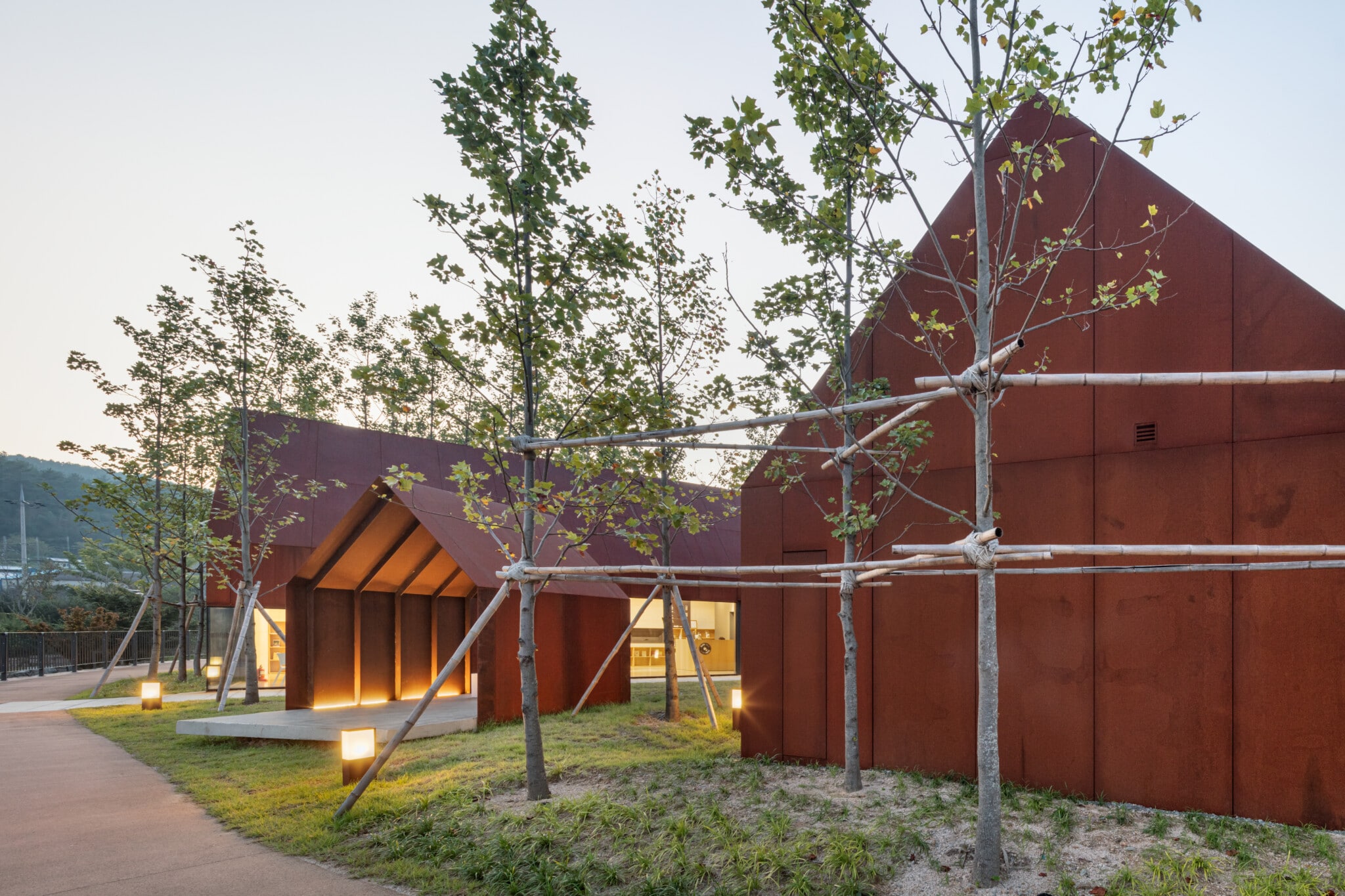Je Jung-Gu Community Center
| 완공년도 | 2021 |
| 위치 | 경상남도 고성 |
| 대지면적 | 19,892.6㎡ |
| 건축면적 | 454.93㎡ |
| 연면적 | 449.38㎡ |
| Contractor | 세움건축 |
| 완공년도 | 2021 |
| 위치 | 경상남도 고성 |
| 대지면적 | 19,892.6㎡ |
| 건축면적 | 454.93㎡ |
| 연면적 | 449.38㎡ |
| Contractor | 세움건축 |
가짐 없는 큰 자유를 위한 작은 숲
제정구 커뮤니티센터는 경상남도 고성군 대가면의 대가저수지에 면해 있는 공원내에 조성된 시설로 제정구선생의 업적을 기리고 주민들과 방문객이 같이 이용할 수 있는 작은 문화공간이다.
제정구선생은 이 고성출신으로 도시빈민의 생존권과 인권보호를 위해 일생을 헌신한 인권운동가로 가짐보다 비우고 나누는 삶을 여러 사람과 더불어 사는 공동체적 삶을 실천하다 병으로 이른 나이에 세상을 떠났다. 선생은 우리 모두의 내면에 흐르는 존엄성에 대해 누구보다 깊이 집착하였으며, 그런 분을 기억하는 집이라면, 보다 근본적 건축이어야 한다고 여겨, 가장 단순한 건축의 형태인 박공지붕의 집을 먼저 그렸다.
또한 선생은 늘 연대하신 분이어서 단독의 건물 보다는 두 채가 더 합당하다고 여겼고, 따라서 단순한 집 두 채를 나란히 놓게 된다. 그러면 그 두 채 사이로 보이는 대가저수지의 풍경은 전에 보이던 풍경보다 더욱 아름답게 보인다. 두 채는 강의실과 전시실 그리고 북카페로 구성된 단층의 건물이며, 이 두 채 사이의 마당에는, 사람들을 늘 환대하신 선생의 정자를 두어 모든 이들이 선생과 같이 있도록 하였다. 또한 입구 마당 가까이 묵상을 위한 탑을 지어 선생이 늘 기원하던 바른 세상을 향한 염원을 기린다. 그렇게 하면 단순한 건물 하나가 아니라 작지만 몇 채가 어우러진 작은 마을이 되어 그 사이에 조성된 외부공간들과 함께 다양함을 더할 것이다.
건물의 재료는 내후성강판으로 5년 동안만 녹이 슬고 그 이후에는 녹슨 피막이 내부의 철을 영구적으로 보호한다. 자연이 관리하니 유지관리를 위한 비용도 들지 않지만, 그보다는 적어도 5년의 시간을 지나면서 피막의 색이 변하는 과정이 마치 시간을 기록하는 듯 변하며 건축이 살아 있는 생명체처럼 느껴지게 된다. 그리고 결국 암적색으로 변한 표면은 기억의 장치로 남는다.
먼저 조성된 테마공원이 나무가 부족한 상황이어서 먼저 숲을 조성하는 게 긴요해 보였다. 이 지역에서 비교적 빨리 자라는 백합나무 백그루를 심어 작은 숲을 이루게 하면 건물이 살아 변하면서 점차 이곳은 울창한 숲으로 성장할 것으로 판단되었다. 그래서 제정구선생의 집이 아니라 제정구선생의 숲을 설계했다고 해도 된다.
또한 이 숲 속에 선생의 일상을 만나게 하기 위해 미술가 임옥상선생에게 부탁하여 일상의 모습으로 빚어진 동상을 설치했다. 어떤 동상은 방문객을 환대하는 모습으로 서 있고 어떤 것은 깊은 사색의 모습으로 혹은 기도하는 모습 등으로 곳곳에서 선생을 만나게 된다.
이 프로젝트는 작은 규모이지만 ‘가짐없는 큰 자유’를 실천하신 선생의 말처럼 물신에 사로잡혀 현대를 사는 우리들에게 우리의 내면에 흐르는 존엄성을 다시 듣게 하여 새로운 삶을 시작하도록 권유하는 시설이 되길 원하며 지어졌다.
The Je Jung-Gu Community Center is a modest cultural space paying tribute to the life and legacy of the late human rights activist Je Jung-Gu. The Center, open to both residents and visitors, is located at a park bordering the Daega Reservoir in Goseong County, Sothern Gyeongsang Province.
Mr. Je, a native of Goseong County, dedicated his life to advocating the human rights of the urban poor including their right to survival. He championed a communal life by practicing the values of living together and sharing as opposed to separation and ownership. More than anyone else, he appreciated human dignity inherent to everyone. The center comprises twin single-story buildings. They feature gabled roofs, the most modest type of roof that befits an architecture commemorating a person who led a humble life.
The twin design of two identical buildings placed side by side embodies Mr. Je’s emphasis on solidarity. The space between the two buildings offers a mesmerizing view of the Reservoir in the background. The buildings house a lecture room, an exhibition hall, and a book café. The yard between the two buildings holds a pavilion which Mr. Jae liked using as a place for entertaining visitors, ensuring that individuals visiting the center feel personally welcomed. Near the entrance to the yard stands a meditation tower inviting visitors to join in Mr. Je’s yearning for a righteous world. Together, they all form a small communal village instead of being just a simple piece of architecture, with its natural surroundings building upon it allure.
The buildings are made of COR-TEN weathering steel. Over five years or so, the steel, left exposed to the elements, develops a rusty coating on its surface which protects the steel permanently. On top of savings on upkeep, the process of rusting with its change in color over time symbolizes the passage of time and makes the building appear as if it were alive, with the final reddish skin serving as a reminder of memory from times past.
The center is designed to be amidst a small grove of yellow poplar trees. For that purpose, 100 saplings were transplanted to form a dense grove as the buildings age. In that sense, the center may also come to be called ‘Je Jung-Gu’s Grove’.
Throughout the grounds statues of Mr. Je are situated to enable visitors to visualize him in various moments of daily activity – welcoming visitors, deep in prayer, and so on. The statues are the work of artist Lim Ok-Sang.
Though small as an architectural project, the Center has been designed to resonate the value of ‘greater freedom from not owning’ as was cherished by Mr. Je, thereby, exhorting them to reject material greed and embark on a new life of sharing in the celebration of human dignity.







